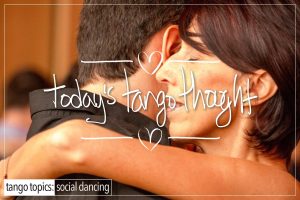You may not realize this but you have an accent. The place that you live in, the people that you dance with, the teachers that you have studied with, and last but not least, the variation of those ideas from the original, creates a local tango ‘accent’. Every city where Tango is danced has an accent which is specific to that place and to that place alone. Boston, San Francisco, Paris, London, Berlin, Moscow, etc. They all have one, up to and including Buenos Aires, especially Buenos Aires! The difference between your local flavor of Tango and say Boston, Paris, and London, is like night and day within a spectrum of ideas.
If you’re thinking that Tango is Tango, an Ocho is an Ocho, a Molinete is a Molinete, a Cross is a Cross, Close Embrace is Close Embrace no matter where you are, think again. It’s not. Not by any stretch of the imagination. There are variations on ideas that are popular within a given geographic area based on a number of relevant factors that you may or may not be aware of: Not the least of which is the popular teaching person/couple, the things that said teacher(s) talk about, the way that person(s) dances, and the people that they they dance with regularly, these are all influences that contribute to where a given populace gravitates towards dancing wise. Now add to that the ripple effect of those influences, and then the people that don’t necessarily study with X or Y, but either witness X or Y, and or their surrogates, and those people see what’s popular and then they’ll try to emulate it. All of this affects the line of dance, their dance partners, their choice of dance partners, which in turn affects the line and lane of dance (floorcraft), and really the people dancing in the room,. Now add to that the dancing venues themselves, the size of the floors at these venues, the quality and choice of the music being played, the quality of dancers at those venues, and even the event atmosphere itself, all of this contributes to the psychology and movement of the dance, which all comes down to a local tango ‘accent’.
Some moves are popular, some embrace ideas are popular, some styles of music get played more often than naught. All of this contributes to the ‘flavor’ of tango that is danced in a given geographic region. Believe it or not this ‘accent’ shapes you, forms you, changes you whether or not you are conscious of it or not. It creates blind spots in you, it creates your idea of tango, it creates places in you where you are familiar with an idea but maybe not all of it’s complexities (for all the reasons listed above), it creates spaces in you that in some places are desirable, and other places it’s not.
What does this mean ? Is all of this ‘bad’ or less than desirable ? Yes and No. ‘Yes’, because it limits you to your available options. And ‘No’ is a very subjective idea. The subjective idea is that we want to be as versatile as humanly possible and then some. To be able to dance with everyone, no matter their ‘style’ or in this case ‘accent’ of tango. So the question arises, should you avoid the local tango ‘accent’ ? Yes. The next question is “how” ? Mark Twain once wrote, “Travel is Fatal To Prejudice…”, the same is true here. To avoid the less than desirable, to avoid the tango doldrums, to avoid complacency, you must, must, must, must travel for Tango as often as is humanly possible, and dance with as many people as is humanly possible. They say it takes a village to raise child. Well the same is true of Tango. It takes many, many, many voices (not just one) to raise a Tango dancer to be desirable everywhere they go! In short, you must get out of Dodge City constantly.
thanks for reading.











